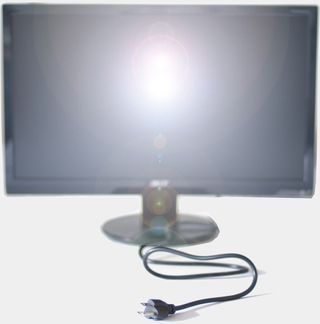Display Power Consumption: CRTs Versus TFT-LCDs
An increasing number of flat panel displays are based on LED backlighting, and their manufacturers aren't shy about promoting the technology's benefits to power consumption. We checked the claims to see if the promised savings are worth emphasizing.

LCD Power Consumption Is In Your Hands!
New LCD flat panel displays are constantly reaching record lows in power consumption: 50 W, 40 W, and even 30 W are sometimes achieved in displays as large as 24” these days. The most important variable in display power savings is the backlight technology. Today, we have fluorescent lighting transitioning to light-emitting diodes (LEDs). We grabbed all of our test lab's LCD monitors and two old CRTs, pitting them against each other in a power consumption shootout.

Display Power Becoming Important
As of late, we've written a lot about power consumption on the system side, where usage is most noticeable. Processors and graphics cards were particularly blatant consumers a few years ago. Nowadays, the trend (especially in Europe) is mostly toward more environmentally-friendly components.
Green computing has forced even the largest corporations to rethink and refocus. We have low-power processors, motherboards, memory modules, hard drives, and even high-efficiency power supplies. Many things have changed, but you still need to look at every product individually to decide whether or not it’s truly efficient.
Interestingly, displays were largely neglected in this "green refresh." Part of the reason was that, ever since LCDs displaced CRT displays, the typical PC utilizes more power than its attached monitor. However, this is changing rapidly. Enthusiast PCs, gaming systems, and workstations still often consume more than 100 W at idle and much more under load. But the majority of PCs sold are business and mainstream systems, and the average power consumption in this group is dropping fast thanks to aggressive optimization.
Display Power Higher Than System Power?
As a result, mainstream PCs that don’t sport discrete graphics and multi-core processors consume reasonable amounts of power. In the article Build a 25 W Performance PC Using Core i5, we proved that a system with above-average performance does not have to draw more than 25 W at idle. Since most 20" or higher flat panels consume 30 or 40 W, it's likely that your display will chew up more power than your nettop or mainstream system.
Stay on the Cutting Edge
Join the experts who read Tom's Hardware for the inside track on enthusiast PC tech news — and have for over 25 years. We'll send breaking news and in-depth reviews of CPUs, GPUs, AI, maker hardware and more straight to your inbox.
We decided to run a little analysis on the following displays from our test lab:
CRT:
- Iiyama Vision Master Pro 454 (19”, 2003)
- Sony Multiscan G420 (19”, 2002)
LCDs:
- 19” Benq FP937S (2005)
- 20” Samsung SyncMaster 204B (2006)
- 24” Samsung SyncMaster 245B Plus (2008)
- 19” Philips 190BW9 (2009)
- 22” Acer P225HQL (2010)
Current page: LCD Power Consumption Is In Your Hands!
Next Page Display Details And LCD Panel TypesMost Popular

